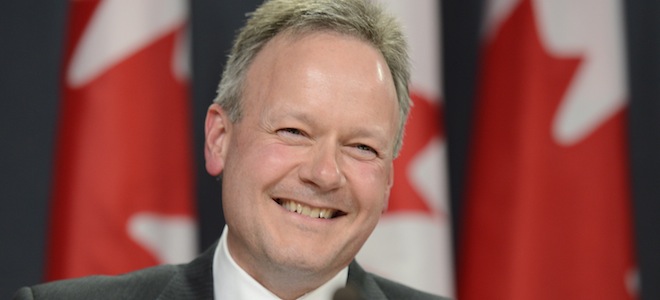10 things you should know about the new Bank of Canada governor
1. His name is Stephen Poloz and his appointment surprised many analysts
Share

Finance Minister Jim Flaherty has named Stephen Poloz the next governor of the Bank of Canada. The announcement shocked analysts who had thought that long-serving senior deputy governor Tiff Macklem was a front-runner. Poloz, head of the federal trade agency Export Development Canada, has a low profile in financial circles.
Here’s a primer on who he is and what he might bring to the job:
1. He is 57 and married to Valerie Poloz. The couple has two children.
2. He spent 14 years at the Bank of Canada, rising to chief researcher, before being appointed chief economist at Export Development Canada in 1999. He is currently the agency’s CEO.
3. During the 1990s, he was managing editor of the Montreal-based International Bank Credit Analyst, an influential financial publication that long warned against jumping into frothy, dot-com fuelled stock-market bubble before it burst.
4. He has also been a visiting scholar at the International Monetary Fund and the Economic Planning Agency in Tokyo.
5. He was previously rumoured to be on the short-list of candidates to replace David Dodge as Bank of Canada governor in 2008.
6. He warned early on of a potential for a major financial crash:
In 1998, after Long-Term Capital Management went bust, requiring a $3.6-billion U.S. government bailout, some analysts shrugged off the episode as the workings of a rogue hedge fund. Poloz was among those who predicted the fund’s failure was more likely a sign of a financial system that was working itself into a bubble built on complex and opaque derivatives, which would eventually require more bailouts. “I think there will be lots more” fund failures, he predicted in 1998.
7. … and then got it wrong after it happened.
In 2007, Poloz predicted the financial crisis would be short-lived. “A key source of comfort during the financial turmoil of recent weeks has been the consensus that the world economy remains strong,” he wrote in an analysis. “This is important, for it means that even if the financial contagion continues to spread, the world economy will prove resilient to the shock.”
8. He helped set the framework for Bank of Canada policies largely seen as successful in helping Canada stave off the worst of the global recession.
In 1994, while still at the Bank of Canada he co-authored a paper describing in detail the central bank’s approach to its medium-term forecasting. It may sound dull, but the paper was a critical step in the bank’s sweeping shift away from clandestine operations and toward more transparency in how it sets monetary policy.
It’s an approach strongly supported by outgoing governor Mark Carney and one that he has signaled he’s bringing to the Bank of England. Carney is a vocal a proponent of more communication and forward guidance from central bankers — signaling to investors where interest rates will likely be headed in the future —arguing that it can be calming on the markets and perhaps induce consumers to adjust their spending.
9. He disagrees with Carney on a few key issues.
Unlike Carney, who has criticized Canadian corporations for sitting on “dead money” instead of investing, Poloz warned in a 2011 speech that the stockpiles of cash were a “necessary insurance against the next black swan” in an era of deep uncertainty about the future of both the Canadians and the global economy.
Carney has also openly dismissed the “Dutch Disease” argument that Canada’s high “petrodollar” is harming the manufacturing economy. Poloz, on the other hand, has publicly warned that the rising Canadian dollar was harming the economy, mainly because it exacerbated the widening gulf between Eastern manufacturing-based economies and Western commodity-based ones.
He has cautioned that such economic divergence would become a long-standing problem in Canada and that similar conditions in the 1970s had led to “stagflation” when inflation rises rapidly but economic growth stalls.
“This two-speed economy thing is enormous,” he told a 2008 conference on how energy industry affects the economy, arguing that the Bank of Canada should pay more attention to the dollar’s exchange rate when setting interest rates.
10. Perhaps he’s so vocal because he initially got it so wrong when it came to the dollar:
In spring 2007, Poloz proclaimed that the Canadian dollar, then sitting at 94 cents, would fall to 84 cents U.S. by the end of the year because the weak U.S. and global economy would hurt demand for Canadian exports. “There is a global slowdown that is grinding through the system, and oil prices are probably going to drift lower rather than higher, and in that context you get the Canadian dollar going down not up.”
Instead, the dollar hit a high of $1.08 in November. It took roughly two years for his prediction to come true — the dollar dropped in 2009 — though the loonie has been stubbornly sitting around par since 2010, thanks largely to strong oil prices.
Some analysts rushed to describe Poloz as an “outsider” whose appointment signals a morale crisis at the Bank of Canada and a push by the Harper Conservatives for more control over monetary policy. Indeed, the Canadian dollar fell on news of his appointment. But Poloz could also be viewed as one of Harvard Business School professor Joseph L. Bower’s “inside outsiders” — the kind of leader who has both deep institutional experience and knowledge, but not so much that he’s become part of the establishment.
A good example of such a leader, according to the Harvard Business Review? Mark Carney.